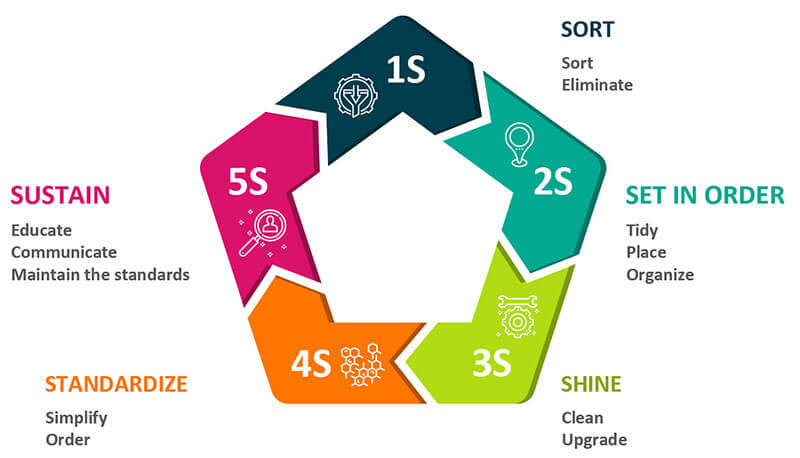INVITING APPLICATIONS
14th SSF EXCELLENCE AWARDS & RECOGNITION – 2025
LAST DATE: JUL-25 | APPLY NOW
Running a lean business has been a rallying point for many a business organization. Many companies love to flaunt their lean initiatives in their production and operational processes, with a variety of numeric figures, KPIs, target achievements, etc. Huge resources are devoted towards these initiatives and very generous bonuses showered upon achieving these goals. But is the business really lean in the real sense?
It is easy to measure the efficiency and other criteria for production or business processes with different KPIs. The question is – is it also easy to measure the overall management processes that drive and run the whole show?
There are several management processes like operations planning, strategy, budgeting, resource planning, etc., which take huge time and effort. For instance, a huge amount of time is required for preparation and distribution of financial statements. It takes a large organization several days to collate financial data for monthly results and weeks for annual results. There could be multiple sources of data like plant locations, local & foreign offices, distributors, subsidiaries, business partners, etc. Thereafter, multiple activities are required to be done on the received data,such as verification, compilation, approval, distribution, etc. This requires devotion of time and resources as businesses are deeply intertwined through different geographies andtime zones, with each providing different sets of data which needs to be collated, analyzedand compiled.
Although management processes have improved significantly over the past few decades, but so have the complexities in business due to the globalization and rapid integration of world economy. Hence, the overall progress has been slow when compared to the impressive improvement shown by the other functional areas in the organization, like production, operations, etc.

In the postCovid-19 environmentfortunes can change abruptly without warning.In these uncertain times, it is imperative that business organizations be very agile and nimble footed, with very fast decision-making ability, based on availability of real-time data round-the-clock. Unfortunately, this may be possible for very few organizations right now.
This brings us to an important question of how to get real-time reliable data for quick decisions. Clearly this is not possible unless the problems obstructing free flow of reliable data in the organization are identified and solved. One can possibly see so many wrong things by just walking around the Finance departments of many organizations. There would be piles of paperwork, urgent voices of people on phone asking for pending information, e-mails with long trail among several people circulating for small issuesand waiting for resolution, people working late during weekends or month-ends correcting mountains of incomplete transactions or reconciling accounts, etc. The most visible of all these things is to regularly see a small army of people engaged in manual processing of financial data for different reports simply because different IT applications do not talk to each other or similar reports being prepared with slightly different formats for usage by various ‘customers’ for a variety of reasons.
Almost all the problems affecting an organization can be summarized in just few points:
1.Regularly chase for information/ data in order to complete a task
2.Required to jump through multiple decision hoops
3.Constant interruptions when trying to complete a task
4.Low understanding of work prioritization
5.Plethora of similar, repetitive tasks in different processes
6.Work or information loss in the gaps between organizational silos
7.Lack of reliable information or being deluged with too much data
Although all this seems to be a complex problem, but the solution could be quite simple. All it requires is a change in mindset and approach. As per the legendary investor, Warren Buffet, “the best kind of investment is one in which a huge return results from a small investment.” Similarly, the solution to all the above seemingly complex problems affecting work processes is to simply use the Lean 5S approach.
Organizations have so far approached the Lean 5S by just bringing about the physical changes in the workplace or changing the work processes by removing the ‘not needed’ items from the workplace. But thatis arguably just a small percentage of this very dynamic concept. Companies could bebenefitting from it hugely by taking it up the entire business value chain.
It is an established fact that majority of the problems in a process are primarily caused by a handful of factors.The Pareto Principle statesthat almost 80% of the problems are caused by just 20% of the process activities. Hence, what is essentially required is to improve the efficiency of these 20% process activities and one can see huge transformation in all the processes. The whole Lean 5S concept of Sort, Set in Order, Shine, Standardize and Sustain can redefine the organizational processes by acting on some innovativeand transformative ideas.
The 5S Explained

- “Sieri” or Sort. This identifies “what is required” and removing from the workplace that is “not required”. An organization has several processes or process items that have been present for a long time. Similarly, many processes have elements which are of not much use but arestill present there and clutter the process. Some such obvious examples include:
- Software bought but not used or software licenses bought but not used at full capacity
- Customer segments or customers that have become uneconomical or unviable to serve over the years but are still served due to reasons other than “business”
- Product offerings that are past their prime and have become a liability now
- Suppliers on the database other than those which are “active”
- Multiple bank accounts, many with no or low use
- Overlapping roles, which makes it difficult to assign responsibility and fixing accountability
- Time and efforts spent in manual work, especially around mountains of data for reporting and analysis
These are just a few typical examples that can possibly be present in any organization. It is important to “Sort” or critically examine all the functional areas like transactional processing, budgeting, financial reporting, control, decision support, etc. and see which ones adds value and needs to be prioritized and which ones can be pushed down the priority list.
- “Seiton” or Set in Order refers to organizing the “required things” in a sequential or logical order. The simple or less priority processes like routine transactional processing, scanning, physical documents handling & storage, IT, payroll processing, recruitment, etc. can be moved out and done through some service providers or outsourced, if otherwise found feasible. Similarly, the required processes can be organized as per the workflow and then analyzed to see how the process efficiency and quality could be increased by removing the bottlenecks and waste elements clogging the flow of value in the process. Alongside, some process improvementmeasures and automation can be done to get meaningful results in quick time.Entire projects could be taken up using Lean or Six Sigma or any other efficiency building methodology in case the problem seems to be a tough nut to crack.
Many of such steps wouldalready have been done in many organizations,but possibly, what was done could well be just treating the symptoms and not the disease.
- “Seiso” or Shine is to keep the workplace clean. It can also be related to keeping the processes clean by removing its weaknesses and making it more robust & predictable. For instance, ‘Segregation of Duties” has proven to be the Achilles heel of many organizations due to its indecisiveness related to lack of clarity between global and local, between corporate and business units, between one function and another, between internal and external partners, etc. This seriously hampers decision-making and creates large bottlenecks in very critical business processes. In this instance, it can be solved by “Shining” the SOD and fixing clear roles and responsibilities, including decision making to clearly define who can recommend, who needs to agree, who provides inputs, who is responsible for taking decisions, who carries out the actionable things and who is accountable for the results. Similarly,“Shining” could be carried out in other functions too, such as Customer Management, Procurement, Vendor Management, Product Lifecycle Management, etc. Likewise, the risks associated with different processes can be identified, treated based on some logical prioritization and tracked to keep deviations within acceptable limits.
- “Seiketsu” or Standardize refers to setting standards to maintain the first three elements of 5S. In large organizations, a variety of processes function individually and alongside each other and provide tons of data to the centralized teams. As a result, mountains of data have to be analyzed and used to get meaningful information out of it. Standardization can help by using IT applications for different tasks. Such applications should be compatible with each other, facilitate smooth process interaction, remove obstacles in inter-dependent processes, and help generate useful reports and analysis in real time. Smooth interaction among different processes will reduce manual intervention and eliminate the need to regularly deploy a small army of people doing data management. It will also help in eliminating waste in several areas, e.g. moving from “Personalization” of reports to “Standardization”. Also, measurement standards for different processes could be set up and process performance measured to keep a check on it. For example, any system generated report should be “Ready to Use” and should not require any manual intervention.
- “Shitsuke” or Sustain refers to maintaining discipline to sustain the gains or improvements achieved so far. The initial momentum gained needs to be maintained in order to sustain the improvements and efficiencies brought into the system. Not doing so runs the risk of wasting all the efforts andinvestments already put in.Apart from this, ‘sustain’also includes keeping the people motivated to inculcate in them the practice of excellence by continuously looking out for improvements in each and every part of the work they do. The concept of continuous improvement should be made a part of routine expectations.
Conclusion
Lean 5S is a continuous process and certainly not a one-time effort. Teams should be encouraged to challenge the status quo to see what further improvements are possible.This can be encouraged by building a culture of process optimization, technology enhancement or by upgrading knowledge by adding relevant information related to key markets, customer segments, economic conditions, etc.Bringing them together under the Lean 5S umbrella in order to completely transform the organization in how it is managed and also how it is being looked at – both internally and externally.
Due to the presence of waste elements in the management and financial processes, a lot of time is spent on just collation and compilation of data.Very little time is left for meaningful analysis and decision making. It is true that many of the activities done earlier manually have been automated, but the basic need for planning and analysis is still there. It helps in paving the future path and also helps in identifying the obstacles and issues. It either clears them or prepares the organization in advance to face adverse situations with ease.
In many organizations, the stakeholders are too busy in focusing on the revenue generating verticals and processes to make them more efficient. The critical support processes associated with these are given less priority which slows them down as they are still riddled with waste, which may be known, but not acknowledged.
Using the Lean 5S “broom” at an organizational level helps in making the entire organization “Lean” and “Agile” in the true sense, by making both the operational and support processes more efficient and helping it getting rid of all the flab and waste that may have gathered over the years.
Better use of technology helps in timely completion of important projects, increases compliance with benchmarks and deadlines,and gives the organization a better insight into its strengths, abilitiesand vulnerabilities. Of course, more the use of AI and technology, easier it will be for decision making; however,all the critical decisions would still lie in the hands of humans, which ultimately decide the fate of organizations.
ABOUT THE AUTHOR

Jasmeet is a Senior Consultant & Project Analyst at Quintes Global, RvaluE Group. He comes with over 16+ years of experience, with long experience in Quality Assurance. He has done projects in multiple domains like IT services, financial services, general insurance, location-based services, etc.
He has a knack of identifying the pain areas and issues which obstructs the free flow of value in business processes. He has the unique experience of being an employee, a business owner and an external consultant and can see the issues from different perspectives which negatively affects a process from achieving its full potential and potential improvement opportunities.



 Ask an Expert
Ask an Expert



